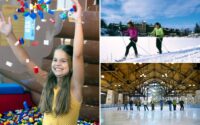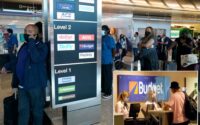Sunken water safaris are indeed a thing in Botswana
The lions fled across the delta, and our Land Cruiser followed.
“They’re not far from here,” whispered our safari guide Dave Luck as he listened, smelled and looked for signs of big cats in the early morning glow of a Botswana sunrise. He navigated our enormous safari vehicle across deep sand, chest-high brush and through four feet of water.
One moment we are driving over dry land, the next we were holding our camera bags over our heads just in case the river’s water would breach the tops of the passenger doors.
It was the kind of drive that made a Jeep commercial look tame.
By the time we found the lions, they were halfway through licking the bones of a fallen buffalo — with full bellies, ready for a cat nap, totally uninterested in us humans who had flown from around the world to come see them.

As someone who has gone on safari all over southern Africa, I walked away from a recent visit to Botswana’s Okavango Delta awestruck by the landscape, the biodiversity, and the old-school sense of adventure.
Much of the national parks and private concessions where safari takes place in Africa are in a savannah or in a jungle — few offer the amphibious, sunken experience that you’ll find in the Okavango.
Driving, boating, going in and out of and over the water — you’re seeing animals from perspectives you won’t see anywhere else on the continent.

A massive alluvial fan which flows from the Angola highlands down into the desert of northwest Botswana, the Okavango Delta is a UNESCO World Heritage Site and one of the world’s most iconic oases. Each year when the rains come, it swells between 2,320 and 5,790 square miles, stretching out in the shape of a hand, offering water and vegetation in the heart of one of the world’s largest deserts, the Kalahari.
The Okavango has long been considered one of the best wildlife viewing sites in the world — a region doesn’t simply become UNESCO protected overnight — but a flurry of new and newly renovated camps in the area make this as good a time as any to visit.
Wilderness Safaris, founded in Botswana in 1983, has become the region’s most robust safari offering, with a range of camps across the delta and beyond, as well as its own air charter company, Wilderness Air, which makes bouncing from camp to camp a seamless experience.


Highlights include: Vumbura Plains, which completed a total renovation in April 2022; and Jao, a marvel of a modern treehouse, fully redesigned in 2019 right before the pandemic.
At both properties, guests can overlook the delta’s flooded landscape from the comfort of their private patios and plunge pools, or opt for a mokoro (dugout canoe) ride through the water lilies, dodging hippos and searching for elephants playing in the water.
Elsewhere in the delta, safari company Natural Selection just opened the new Duke’s Camp (from $695 per person, per night), designed in the retro-inflected campaign style that made its sister property San Camp (located a short flight away on the Makgadikgadi Pan) such a hit, as well as the setting for Taylor Swift’s 2015 “Wildest Dreams” music video.

“There are other destinations where we see a greater number of travelers, but for those in the know, the delta is really one of Africa’s, if not the, premier safari experience,” said Alex Malcolm, founder of luxury African tour operator Jacada.
He has noticed an uptick in clients looking to visit the delta, but the region’s “high value, low volume” tourism model, he said, keeps things calm.
Now, in a time when a simple flight from New York to Miami can be a harrowing experience, and the post-COVID travel bounce back has rendered destinations from Nantucket to Croatia completely overrun with visitors, Malcolm thinks there is no time like the present to finally take that bucket list trip.
“The delta will always feel like your own given just how few lodges there are,” he said. “Travelers really feel like they have the whole place to themselves.”


